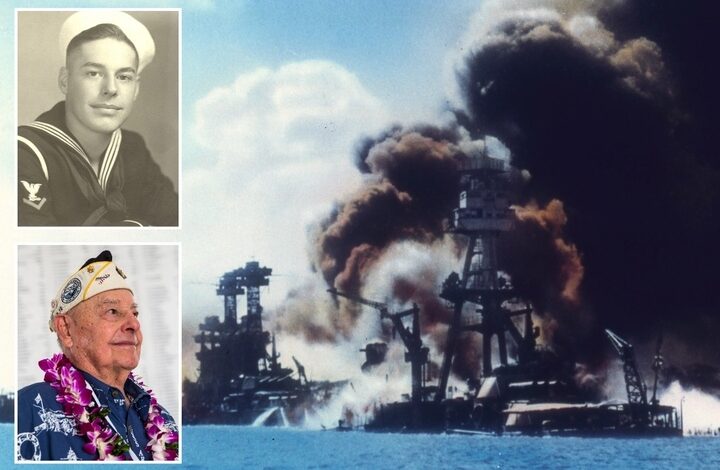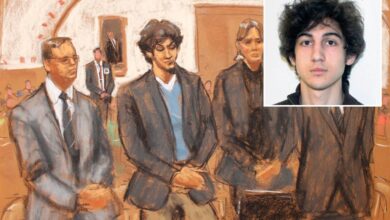Last USS Arizona survivor, Lou Conter, never forgot tragedy of Pearl Harbor

The tragedy of Pearl Harbor lasted for just over an hour before becoming the “date that shall live in infamy.”
And Louis “Lou” Conter remembered every brutal second of it.
The tough last survivor of the USS Arizona, he was on deck when the Navy ship was bombed and sunk by the Japanese in the surprise attack at the Hawaiian harbor on Dec. 7, 1941, killing 1,177 men on board — nearly half of the Americans lost that day.
Conter, 102, died of congestive heart failure Monday at his home in Grass Valley, California, surrounded by his family, according to Joint Base Pearl Harbor-Hickam and Pacific Historic Parks, citing Conter’s daughter Louann Daley. He achieved the rank of Lieutenant Commander and was a naval aviator.
The vet used his long life to keep the memories of Pearl Harbor alive — and was doing interviews up until he was 100 years old.
At just 20 years old, Conter was the quartermaster on watch at 7:55 a.m. that Sunday as sailors were starting to raise the flag and hoist colors.
“It was five minutes to 8, and the first plane came across,” Conter recalled in a 2022 interview with KCRA-TV.
“As soon as they came in, we knew what was happening. We knew for six months we were training hard for fighting the Japanese at war,” he said. “They were dive bombing, and they were right down the ship’s edge. We didn’t have time to look up and see what was coming. They were already right down at the water’s edge.
“”It lasted for about 40 minutes. We took a 50-60-hundred-pound bomb alongside the number two turret. It went through five decks in the forward lower handling room and blew the power up there for the number one and number two turret, and the whole bow came up out of the water.”
One bomb blasted through the five steel decks 13 minutes after the aerial assault began — and ignited more than 1 million pounds of gunpowder stored in the hull below.
The explosion propelled the battleship about 40 feet in the air and set it on fire from the mainmast forward, Conter said in an oral history interview conducted in 2008 and stored at the Library of Congress.
When the first big blast hit, he was one of the lucky ones: knocked forward on the deck, while others were thrown off the ship and into the water.
Conter and other sailors began helping the injured men, trying to prevent them from jumping overboard.
“Guys were running out of the fire and trying to jump over the sides,” he said in 2008. “Oil all over the sea was burning.”
“We were just grabbing them [as they came out of the fire] and laying them down,” Conter told KCRA. “They were real bad. You would pick them up by the bodies, and the skin would come off your hands.
“There was no time to do anything. It happened so fast.”
As the USS Arizona sank beneath the waves at Oahu, “We took the boats and picked up bodies out of the water.”
Conter’s 2012 autobiography, “The Lou Conter Story: From USS Arizona Survivor to Unsung American Hero,” recounts how he later joined other survivors in tending to the injured, many of them blinded and badly burned.
The sailors only abandoned ship when their senior surviving officer was sure they had rescued all those still alive.
During the massive air attack that Sunday morning, a total of 19 ships and 188 planes of the Pacific Fleet were lost. Altogether, 2,403 Americans died and 640 were never accounted for. More than 1,100 were wounded. The US entered World War II as a result.
Conter, whose memory seemed to be razor-sharp up until the end, was blunt about some of the tall tales that came out after the attack — notably, that many of the seamen were fast asleep when the Japanese attacked.
“A lot of stories came out and said they were in their bunks asleep since they played in the Battle of the Bands the night before — that was a lot of bull,” Conter told Navy Times. “They went to their battle stations, they were all killed at their battle stations.”
Some of the dead at Pearl Harbor were buried with no information about them. The remains of 647 servicemen lie in the National Cemetery of the Pacific in Hawaii with granite markers that say only “Unknown.”
The USS Arizona remains sunken in Pearl Harbor. Half of the dead at Pearl Harbor were on the Arizona. A United States flag flies above the sunken vessel, which serves as a memorial to all Americans who died in the attack.
After the tragedy, Conter went to flight school and flew 200 combat missions in the Pacific with the stealth “Black Cats” squadron that dive-bombed at night in planes painted black.
In 1943, he and his crew were shot down in shark-filled waters near New Guinea
One sailor worried they’d never make it out alive.
“Baloney,” Conter said.
“Don’t ever panic in any situation. Survive is the first thing you tell them. Don’t panic or you’re dead,” he recalled saying at the time.
The sailors went silent and treaded water and before long another plane came and dropped them a lifeboat.
Conter used the lessons he learned from his near-death experiences when he became the Navy’s first SERE (Survival, Evasion, Resistance, and Escape) officer in the late 1950s — and spent more than a decade training Navy personnel how to survive if they were shot down or captured as a prisoner of war.
Preceded in death by his third wife, Valerie, he leaves behind a daughter, three sons and several grandchildren and great-grandchildren.
There was an outpouring of tributes in real life and online after Conter’s death, including one on Facebook that invoked the traditional farewell to a courageous sailor on his next journey:
“Fair winds and following seas, shipmate, we have the watch.”
Get Best News and Web Services here







